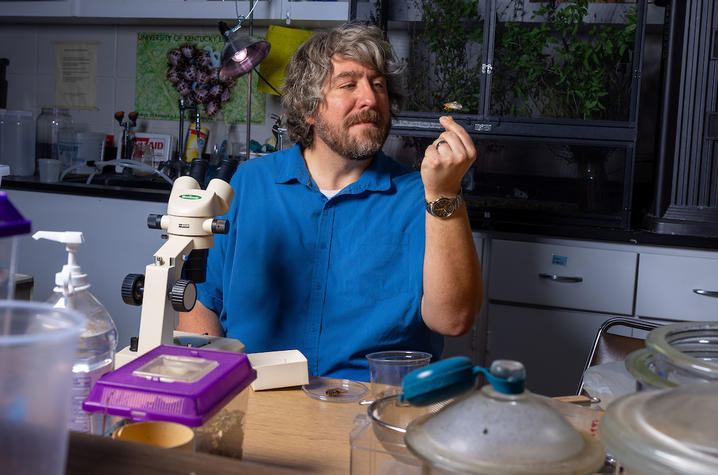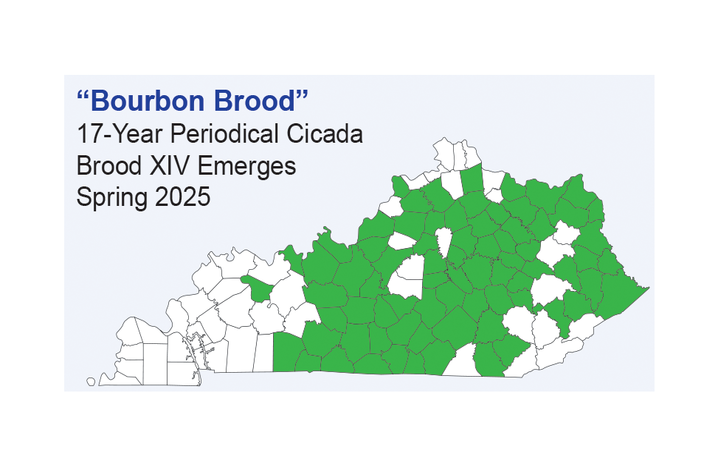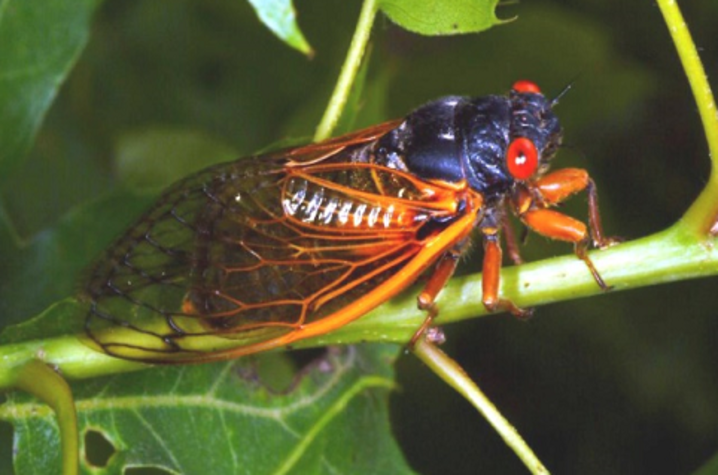Bourbon Brood of periodical cicadas ready to sing this spring in Kentucky
LEXINGTON, Ky. (April 11, 2025) — Kentucky will be the epicenter for the emergence of Brood 14 of 17-year periodical cicadas this spring. Designated the “Bourbon Brood” by University of Kentucky Martin-Gatton College of Agriculture, Food and Environment entomologists, these time-keeping insects are characterized by their red eyes and loud singing.
Periodical cicadas have appeared in Western Kentucky counties over the past few years, but the largest emergence area for 2025 will occur across most of Central and Eastern Kentucky.
According to Jonathan Larson, assistant extension entomology professor in the Department of Entomology at UK Martin-Gatton CAFE, the 17-year periodical cicadas emerge from the soil to molt into their flying, adult form in late April to early May, much earlier than annual cicadas.
“We will begin seeing this brood of cicadas when the soil warms to the mid-60s, about the same time you start to see iris blooms,” Larson said. “A lot of people hate them, but I hope they will learn to appreciate them as periodical cicadas are such a rarity.”
Larson explained that the periodical cicada nymphs live in the soil, feeding on the sap of tree roots. They count their feeding cycles to know when to emerge and prepare for molt. Not all cicadas appear in the correct year; the few that do not are referred to as stragglers.
What to expect at emergence
Cicadas are not harmful to humans, pets or wildlife, as they do not bite or sting. While some may compare cicadas to locusts, Larson said they do not swarm and cause massive plant damage. Adult cicadas feed on sap with little impact to the plant.
Local wildlife, such as snakes, foxes and turkeys, will benefit from the extra protein provided by the cicadas. Although Larson mentioned that the surge in cicada numbers won’t immediately boost the population of predatory animals in high-emergence areas, it will likely lead to increased feeding activity. He advised people to be aware.
In addition to the many nymph exoskeleton shells left behind on tree trunks and nearby objects, the adult cicadas’ sound will be difficult to avoid.
“A song from a large congregation of cicadas can be deafening, rivaling the sound made by a jet engine,” Larson said. “Only the males can produce the sound, and their first song is to encourage other males to congregate in sunlit trees. Another choral song is then made to attract females. The males will die shortly after mating, and the females will begin laying their eggs.”
Protecting trees and shrubs
Larson said egg laying is the part of the periodical cicada lifecycle that can be problematic for orchards, tree nurseries and landscapers.
Female cicadas will bore their ovipositor into young, tender tree or shrub branches and deposit 200-600 eggs. This “flagging” may cause the branches to snap. While not beneficial for a growing tree, a fallen branch makes for a much shorter journey for the hatching nymphs from egg to soil. A heavy population of nymphs in the soil may also impact the tree’s root system.
While using insecticides may be less costly, Larson said the safest and most effective way to prevent tree and shrub damage is by using cicada netting, which prevents females from laying their eggs.
Netting is suggested for use on new and smaller trees: oak, apple, arborvitae, ash, beech, berry and grape vines, crab apple, cherry, dogwood, hickory, holly, maple, lilacs, magnolia, peach, pear, rose bushes, spirea and willows. It should be installed when the cicadas begin to sing, about mid-May for most of the area. Trees that are established in the landscape — too tall to net for most people — will grow throughout the egg-laying period.
“By using the netting, we won’t be harming these wonderful examples of nature’s pageantry,” said Larson.
For additional information on periodical cicadas from the UK Department of Entomology, visit https://entomology.ca.uky.edu/ef446.
As the state’s flagship, land-grant institution, the University of Kentucky exists to advance the Commonwealth. We do that by preparing the next generation of leaders — placing students at the heart of everything we do — and transforming the lives of Kentuckians through education, research and creative work, service and health care. We pride ourselves on being a catalyst for breakthroughs and a force for healing, a place where ingenuity unfolds. It's all made possible by our people — visionaries, disruptors and pioneers — who make up 200 academic programs, a $476.5 million research and development enterprise and a world-class medical center, all on one campus.







